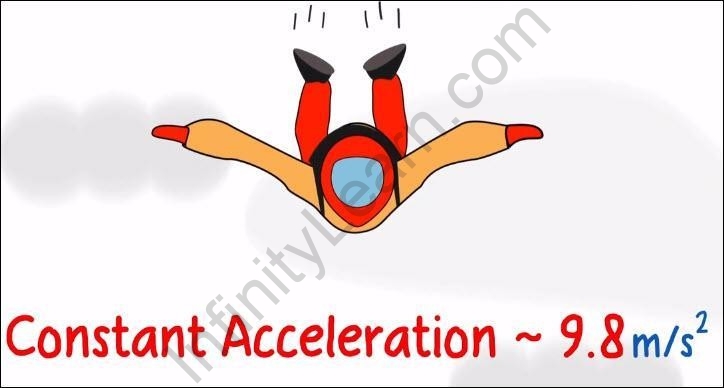Table of Contents
Table of Contents
- Uniform Acceleration – Definition
- Non-uniform Acceleration – Definition
- Summary
- Did You Know?
- What’s Next?
In the previous segment, we learned about negative and positive acceleration. In this segment, we will learn about Uniform acceleration and Non-uniform acceleration with the help of some examples.
What is Uniform acceleration?
In Uniform acceleration, the velocity changes by a constant amount in equal intervals of time.
Uniform acceleration is a type of motion where the velocity of an object changes at a constant rate over a given period of time. This type of motion is commonly seen in everyday life, such as when a car is gradually accelerating from a standstill to a certain speed. The acceleration in this case is constant, meaning that the speed at which the car is increasing remains the same over the duration of the acceleration.
The most basic equation for uniform acceleration is the equation of motion which states that the velocity of an object is equal to its initial velocity plus the product of its acceleration and the time elapsed. This equation can be used to calculate the velocity of an object at any given time, provided the initial velocity, acceleration, and time elapsed are known.
In addition to the equation of motion, there are several other equations which can be used to calculate various aspects of uniform acceleration. For example, the equation for the distance traveled by an object during uniform acceleration can be derived from the equation of motion and is equal to the initial velocity multiplied by the time elapsed, plus one half the product of acceleration and the square of the time elapsed. This equation can be used to calculate the amount of distance an object has traveled after a given period of time.
Finally, the equation for the average velocity of an object during uniform acceleration can be derived from the equation of motion and is equal to one half the sum of the initial velocity and the velocity of the object at the end of the acceleration. This equation can be used to calculate the average speed of an object over a given period of time.
Example
The motion of a free-falling body is an example of uniform acceleration. It is free-falling when it is under the sole influence of gravity. The body accelerates at a constant rate of 9.8 .

Uniform acceleration – Example
What is Non-uniform acceleration?
In Non-uniform acceleration, the velocity does not change by a constant amount in equal intervals of time.
Non-uniform acceleration is the acceleration of an object that is not constant over time. It can be due to a variety of factors, such as a changing force applied to the object, or a change in the mass of the object. Non-uniform acceleration can have several implications, such as the need to continually update equations of motion to account for the changing velocity, or a change in the energy of the system.
The most common example of non-uniform acceleration is when an object is subject to a changing force, such as gravity or friction. In this case, the acceleration of the object is not constant, but changes over time. For example, when an object is dropped, it accelerates at first slowly, then more rapidly until it reaches its terminal velocity. This is because the force of gravity is constantly changing as the object moves.
Non-uniform acceleration can also be caused by a change in the mass of the object. For example, if a rocket were launched and burned fuel to propel itself, the mass of the rocket would be constantly changing. This would cause the rocket to experience non-uniform acceleration, as the force applied would be constantly changing.
Example
For example, when a car turns a corner, the centrifugal force that acts on it can cause it to slide off the road or spin out of control.




